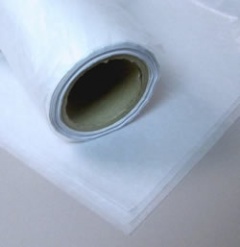Glassine (Glazed Transparent Paper)
| Infobox on Glassine (Glazed Transparent Paper) | |
|---|---|
| Example of Glassine (Glazed Transparent Paper) |  |
| Facts | |
| Origin | - |
| Stowage factor (in m3/t) | - |
| Humidity / moisture | - |
| Ventilation | - |
| Risk factors | See text |
Glassine (Glazed Transparent Paper)
Contents
Description
Glassine is a very thin and smooth paper that is air and water resistant. It is translucent unless dyes are added to colour it or make it opaque. It is manufactured by supercalendering: after pressing and drying, the paper web is passed through a stack of alternating steel and fiber-covered rolls called a supercalender at the end of the paper machine such that the paper fibres flatten facing in the same direction.
Application
Glassine is employed as an interleaving paper in bookbinding, especially to protect fine illustrations from contact with facing pages; the paper can be manufactured with a neutral pH, and can prevent damage from spilling, exposure, or rubbing. Glassine adhesive tape has been used in book repair. In chemistry, glassine is used as an inexpensive weighing paper. It is used in foodservice as a barrier between strips of products (for example: meat, baked goods). Glassine is resistant to grease and facilitates separation of individual foodstuffs.
Glassine is also recommended for protecting the surface of stored acrylic paintings.
Glassine is used as a base paper for making greaseproof paper.
Philatelists use glassine envelopes to store stamps, and stamp hinges are sometimes made of glassine.
Amateur insect collectors use glassine envelopes to store specimens temporarily in the field before they are mounted in a collection. Entomologists collecting for research may likewise use glassine envelopes to store whole specimens in the field. However, if the research involves DNA or other tissue analysis the relevant parts of the body (for example: abdomen or testes) will be placed immediately in a preservative such as ethanol. When this is done for Lepidoptera (moths and butterflies) the wings will often be separated and stored indefinitely in glassine envelopes in case the wing patterning or venation is required later to confirm the identity of a specimen.
Glassine envelopes are used to carry pharmacy reformulated drugs and prohibited drugs such as cocaine and heroin.
In the mid-20th century, potato chips were packaged in glassine bags.
Glassine packages firecrackers.
Glassine is used for its transparent qualities to fold origami tessellations.
Glassine is an outer covering on cardboard tubes, particularly those used in model rocketry, for water protection.
Shipment / Storage / Risk factors
The majority of Glassine is exported in reels, but when sold in sheeted form is packed in individually wrapped reams with wooden cases or bales or on wrapped pallets. Moisture damage causes surface disfiguration, discolouration and wrinkling. A common cause of damage, apart from moisture, is physical impact causing damage to the edge of the reel or collapse of the core. Heat causes Glassine to go brittle, blister or char, but not to stick together.











